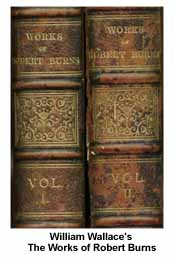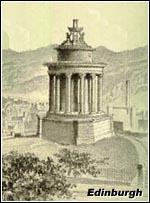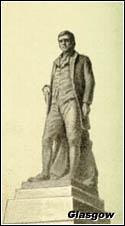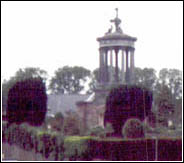 No one knows for certain when the first Robert Burns Day took place, but we do know that it became a fashion in Scotland a few years after his death to meet on the anniversary of his birthday and raise a toast to the Bard's memory. No one knows for certain when the first Robert Burns Day took place, but we do know that it became a fashion in Scotland a few years after his death to meet on the anniversary of his birthday and raise a toast to the Bard's memory.
Within a few short years the fashion spread throughout Scotland, the United Kingdom, the United States, Canada, Australia and New Zealand - in fact to everywhere and anywhere there were Scottish people speaking the Scottish dialect.
On the one hundredth anniversary of Robert Burns birthday in 1859, one of the largest Burns Day's in history took place. Scotsmen and admirers all over the world celebrated the poet's centennial anniversary in what was then the largest event of its kind.
More than 140 years have passed since that wonderful occasion, and if not for the foresight of one William Wallace MA, the centenary celebrations of Robert Burns birth would be lost to history.
The Book
William Wallace was the editor of The National Edition of the Works of Robert Burns, a two volume publication of Robert Burns poetry.  Although we do not have a publication date, we can assume by the book's contents that it was printed in the early 1880s. Although we do not have a publication date, we can assume by the book's contents that it was printed in the early 1880s.
As was the practise of the day, the two volumes were beautifully bound in brown half leather and printed by Dunn and Wright, Glasgow. The books title is in gold embossed letters which proudly state "Works of Robert Burns".
While the book is an antique and a conversation piece in itself, its contents are a virtual treasure trove for collectors of Robert Burns memorabilia.
For our purposes, we plan to focus on Wallace's treatment of the 100th anniversary of Robert Burns birthday, on January 25, 1859, and what happened that day in Scotland.
From The Centenary of Burns
Wallace was so impressed with the quality and quantity of Burns Centenary Celebrations that he devoted 23 pages of his book to the topic under the title "From the Centenary of Burns". One of the first things Wallace points out is the sheer number of 100th anniverary events that took place all around the world:
"In Scotland, 676; England 76; Ireland, 10; Colonies, 48; United States, 61; Copenhagen,1. Total, 872..."
Somewhat of a poet himself, Wallace summarized events in Scotland by starting with the northernmost Robert Burns Day event, and working his way down through the "whole length and breadth" to the south of Scotland.
So numerous were the towns and villages over all Scotland and in England, where Robert Burns was publicly remembered on January 1859, that the names have actually been presented in alphabetical order, and a pretty long list they make. Even to enumerate the whole would be as tedious as unnecessary. We shall content ourselves, therefore, with specifying some of the principal points of interest. Placing the map before us, we put our finger upon North Yell, Shetland, and there we have the praises of Robert Burns ringing out in the parish school-house, speeches made, and songs sung in the remotest corner of cauld Caledonia. Coming slowly southwards, we find the population at Lerwick, Kirkwall, Thurso, Tain, Cromarty and Ginwall all alive with the bustle of preparation or actual enjoyment of feast and festival, till we pause at Inverness, where the Curling Club dine in the Caledonian Hotel upon the true substantial curler's dinner of beef and greens, and the toast of the day is received with genuine Highland cheers, and Highland honours. Then on to Aberdeen, where both old and new towns send for their brightest and best, to testify to departed genius, and so down to Perth, and St. Andrews, and Stirling, and Dundee, till, passing through Edinburgh we reech Peebles, and Kelso, and Jedburgh, and thence to Kirkcudbrightshire and Wigton. Down to Galloway, the farthest southern "mull' of Scotland, to be there met by the long string of the champions of the national bard that have been gathering on the western side; by Greenock, Paisley, Kilmurnock, Irvine, Stranraer, down to the same land's end; through the whole length and breadth of the mountains and glens, cities, villages and hamelts, which combine in making Scotland a most romantic country.
page 368
 Although we would love to reprint the entire 23 pages from Wallace's book, we think it would be easier for our readers to digest the following excerpts which give highlights of the Centenary celebration in different locations around Scotland, particularly Edinburgh, Glasgow, Ayr and Dumphries. Although we would love to reprint the entire 23 pages from Wallace's book, we think it would be easier for our readers to digest the following excerpts which give highlights of the Centenary celebration in different locations around Scotland, particularly Edinburgh, Glasgow, Ayr and Dumphries.
In Edinburgh
In Edinburgh, celebrations began around 2 pm with the main event taking place at the Music Hall. There, Robert Burns son, Col. Burns, was a special guest. Invite only parties for VIP's didn't seem to discourage the working people though, for as Wallace noted, they enjoyed themselves too by taking the afternoon off and going to their own private parties.
"About two o'clock, without concert, but with one accord, shopkeepers began to shut up; and within little more than an hour after, crowds were in all parts of the town to be seen proceeding to the various places in which the Centenary Festivals were to be held. Long lines of cabs and carriages extended from all the entrances to the Music Hall, and groups of spectators gathered at every door, or promenaded George Street, observing the arrivals...."
p. X, Vol. II
A number of prominent persons spoke at the Music Hall, including Col. Burns. This is what he had to say:
"My mother told the late Mr. McDiarmid of Dumfries, that my father once said to her "Joan, one hundred years hence they'll think mair o' me than they do now." How truly this prophecy has been fulfilled, the proceedings here and elsewhere amply testify."
p. 348.
Another person who made a big impression at the Music Hall that day was 100 year old Mr. Walter Grover, 'an obscure individual" who, although he wasn't rich or famous, was deemed worthy of attending the event because he had been born in 1758 and had known Burns.
"The old man, to the amazement of the audience, recited "Tam o' Shanter", from end to end, in a strong voice and with "due emphasis and discretion."
p. 341
Also in Edinburgh that day, there was a Grand Citizen Banquet held in the Corn Exchange under the auspices of the Total Abstinence Society where 1500 people enjoyed Burns' song and speech. Wallace describes the setting:
"...the decorations were scarely less striking in taste and brilliancy than on the occasion of the celebrated Crimean Banquet, in the same place, of 1857. Flags and banners waved from wall and ceiling, while enourmous garlands of evergreens and artificial flowers were suspended from arch to arch of the roof"
p. 345
 Still another event was held at the Queen Street Hall, Edinburgh by the Trades' Delegates. Still another event was held at the Queen Street Hall, Edinburgh by the Trades' Delegates.
Glasgow
After Edinburgh, the biggest celebrations were held in Glasgow. Wallace writes:
"No fewer than 23 meetings took place in Glasgow on the evening of this 25th January, 1859. The City Hall was of course, the theatre of the largest, and was magnificently decorated for the occasion. In front of the organ was suspended a huge screen, painted to represent various scenes and objects connected with Burns - the brig of Doon, the Ayr monument, the ault Alloway Kirk, and the cottage in which he was born; also the mausoleum at Dumfries, with its local scenery. On the extreme left was represented the Edinburgh monument, with the Craigs and Arthur's Seat in the background; while in the center of this composite landscape was represented a bronze statue of the poet, ten feet high."
p. 346
Wallace also notes that 600 "gentlemen" met in the Merchant's Hall, Glasgow, another large company dined in the Tantine Reading Room, another in the Trade's Hall, another in the King's Arms, and a specially select group, dined in the Royal Hotel, George Street.
 In Ayr In Ayr
Not to be outdone by the larger cities with less of a connection to Burns than they, organizers in Ayr made sure that the poet was appropriately recognized. It helped that Ayr had some of the main monuments dedicated to Burns, including the Alloway Monument, the Tam O'Shanter Inn, and his birth place.
"The "auld toon" of Ayr celebrated this memorable 25th January 1859 after its own fashion. In the arly part of the day all the different lodges of Ayr and Kilwinning moved in procession to the Old church, when, having taken their seats in the area- while the public, or rather a fraction of the public, who craved admission, were accommodated in the galleria - a few verses of the ninetieth psalm was sung, and prayer offered up by the Rev. Francis Rae."
p. 353
Later, the crowd assembled at the monument, where Rev. Wm. Buchanan, chaplain of Ayr St. Paul's Lodge, gave an address. This was followed by a banquet at the County Hall, Ayr, another meeting at the Assembly Rooms in Ayr and a celebration at the cottage where Burns was born.
In Dumfries
"The centenary of Burns was celebrated in Dumfries with demonstration of the most imposing character, and with an enthusiasm which, for extent and intensity, was quite unexampled in the history of the town."
p 356
 With an introduction like that, you would expect to read a long list of activities in Dumfries on Robert Burns Day 1859. But quantity obviously did not mean quality in Dumfries. Rather, Wallace tells us there was a procession followed by a grand dinner in the Assembly Rooms under the auspices of the Burns' Club. In the evening, more than 1000 people attended a "monster" entertainment at Nithsdale Mills. With an introduction like that, you would expect to read a long list of activities in Dumfries on Robert Burns Day 1859. But quantity obviously did not mean quality in Dumfries. Rather, Wallace tells us there was a procession followed by a grand dinner in the Assembly Rooms under the auspices of the Burns' Club. In the evening, more than 1000 people attended a "monster" entertainment at Nithsdale Mills.
Wallace sums up his examination of the Centenary celebrations with the following observation of the importance of Burns Day. Interestingly, he links Robert Burns to the prevailing spirit of democracy and independence, ideas which were certainly on the minds of many people in the mid-19th century:
"In conclusion, nothing strikes us more forcefully in the survey of this magnificent 25th January, 1859, than the fervant sympathy everywhere expressed with the cause of worth and independence apart from all contingencies of rank and fortuna. Surely, this is significant of the gradual advance of those liberal principles, which are not certainly on the decline at the present day."
p. 359
by MJ, January, 2000
Thanks to Brian Orr for the use of his book, The National Edition of the Works of Robert Burns, by William Wallace MA.
Source for text and some images on this page from William Wallace MA, The National Edition of the Works of Robert Burns, Published circa 1880 by Cassell, Petter, Calpin and Co., London,
Paris & New York, Printed by Dunn and Wright, Glasgow.
|

 No one knows for certain when the first Robert Burns Day took place, but we do know that it became a fashion in Scotland a few years after his death to meet on the anniversary of his birthday and raise a toast to the Bard's memory.
No one knows for certain when the first Robert Burns Day took place, but we do know that it became a fashion in Scotland a few years after his death to meet on the anniversary of his birthday and raise a toast to the Bard's memory.
 Although we would love to reprint the entire 23 pages from Wallace's book, we think it would be easier for our readers to digest the following excerpts which give highlights of the Centenary celebration in different locations around Scotland, particularly Edinburgh, Glasgow, Ayr and Dumphries.
Although we would love to reprint the entire 23 pages from Wallace's book, we think it would be easier for our readers to digest the following excerpts which give highlights of the Centenary celebration in different locations around Scotland, particularly Edinburgh, Glasgow, Ayr and Dumphries. Still another event was held at the Queen Street Hall, Edinburgh by the Trades' Delegates.
Still another event was held at the Queen Street Hall, Edinburgh by the Trades' Delegates. In Ayr
In Ayr With an introduction like that, you would expect to read a long list of activities in Dumfries on Robert Burns Day 1859. But quantity obviously did not mean quality in Dumfries. Rather, Wallace tells us there was a procession followed by a grand dinner in the Assembly Rooms under the auspices of the Burns' Club. In the evening, more than 1000 people attended a "monster" entertainment at Nithsdale Mills.
With an introduction like that, you would expect to read a long list of activities in Dumfries on Robert Burns Day 1859. But quantity obviously did not mean quality in Dumfries. Rather, Wallace tells us there was a procession followed by a grand dinner in the Assembly Rooms under the auspices of the Burns' Club. In the evening, more than 1000 people attended a "monster" entertainment at Nithsdale Mills.